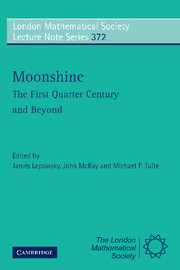 Moonshine - The First Quarter Century and Beyond
Moonshine - The First Quarter Century and Beyond Published online by Cambridge University Press: 06 July 2010
Abstract
A general procedure is presented, associating a premodular category to a finite crossed module, generalizing the representation category of the double of a finite group, and the extent to which the resulting premodular category fails to be modular is explained.
Introduction
Modular Tensor Categories (MTCs for short) have attracted much attention in recent years, which is due to the recognition of their importance in both pure mathematics – 3-dimensional topology, representations of Vertex Operator Algebras (VOAs for short) – and theoretical physics (Rational Conformal Field Theory, Topological Field Theories). They are also closely related to Moonshine: a most interesting (and mysterious) example of a Modular Tensor Category, which is responsible for some of the deeper aspects of Moonshine, is the MTC associated to the Moonshine orbifold, i.e. the fixed point VOA of the Moonshine module under the action of the Monster: note that this MTC is yet to be rigorously constructed.
As in every branch of science, a deeper understanding of Modular Tensor Categories requires a suitable supply of examples. Since the work of Huang, we know that the module category of any rational VOA (satisfying some technical conditions) is modular, but this important result doesn't help us that much, because VOAs are pretty complicated objects usually hard to deal with. This leads to the desire of associating MTCs to simpler and more accessible algebraic objects. There are several such constructions, a most notable case being the one that associates to a finite group the module category of its (Drinfeld) double.
To save this book to your Kindle, first ensure [email protected] is added to your Approved Personal Document E-mail List under your Personal Document Settings on the Manage Your Content and Devices page of your Amazon account. Then enter the ‘name’ part of your Kindle email address below. Find out more about saving to your Kindle.
Note you can select to save to either the @free.kindle.com or @kindle.com variations. ‘@free.kindle.com’ emails are free but can only be saved to your device when it is connected to wi-fi. ‘@kindle.com’ emails can be delivered even when you are not connected to wi-fi, but note that service fees apply.
Find out more about the Kindle Personal Document Service.
To save content items to your account, please confirm that you agree to abide by our usage policies. If this is the first time you use this feature, you will be asked to authorise Cambridge Core to connect with your account. Find out more about saving content to Dropbox.
To save content items to your account, please confirm that you agree to abide by our usage policies. If this is the first time you use this feature, you will be asked to authorise Cambridge Core to connect with your account. Find out more about saving content to Google Drive.